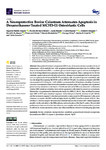A Neuroprotective Bovine Colostrum Attenuates Apoptosis in Dexamethasone-Treated MC3T3-E1 Osteoblastic Cells

Öffnen
Autor
Martin-Aragon S; Bermejo-Bescós P; Benedí J; Raposo C; Marques F; Kydonaki EK; Gkiata P; Koutedakis Y; Ntina G; Carrillo AE; Amorim T. ADatum
2021Schlagwort
Zusammenfassung
Glucocorticoid-induced osteoporosis (GIO) is one of the most common secondary forms of osteoporosis. GIO is partially due to the apoptosis of osteoblasts and osteocytes. In addition, high doses of dexamethasone (DEX), a synthetic glucocorticoid receptor agonist, induces neurodegeneration by initiating inflammatory processes leading to neural apoptosis. Here, a neuroprotective bovine colostrum against glucocorticoid-induced neuronal damage was investigated for its anti-apoptotic activity in glucocorticoid-treated MC3T3-E1 osteoblastic cells. A model of apoptotic osteoblastic cells was developed by exposing MC3T3-E1 cells to DEX (0–700 μM). Colostrum co-treated with DEX was executed at 0.1–5.0 mg/mL. Cell viability was measured for all treatment schedules. Caspase-3 activation was assessed to determine both osteoblast apoptosis under DEX exposure and its potential prevention by colostrum co-treatment. Glutathione reduced (GSH) was measured to determine whether DEX-mediated oxidative stress-driven apoptosis is alleviated by colostrum co-treatment. Western blot was performed to determine the levels of p-ERK1/2, Bcl-XL, Bax, and Hsp70 proteins upon DEX or DEX plus colostrum exposure. Colostrum prevented the decrease in cell viability and the increase in caspase-3 activation and oxidative stress caused by DEX exposure. Cells, upon colostrum co-treated with DEX, exhibited higher levels of p-ERK1/2 and lower levels of Bcl-XL, Bax, and Hsp70. Our data support the notion that colostrum may be able to reduce DEX-induced apoptosis possibly via the activation of the ERK pathway and modulation of the Hsp70 system. We provided preliminary evidence on how bovine colostrum, as a complex and multi-component dairy product, in addition to its neuroprotective action, may affect osteoblastic cell survival undergoing apoptosis.